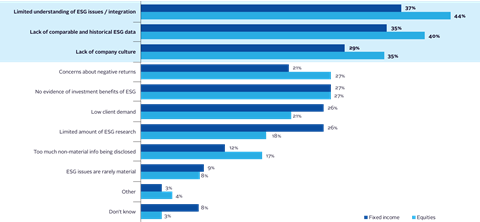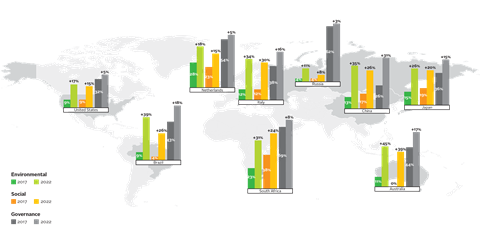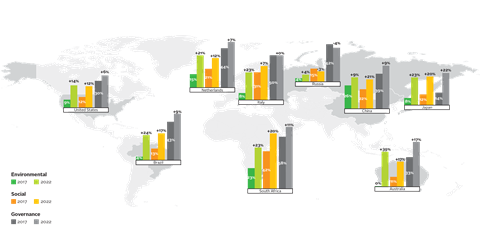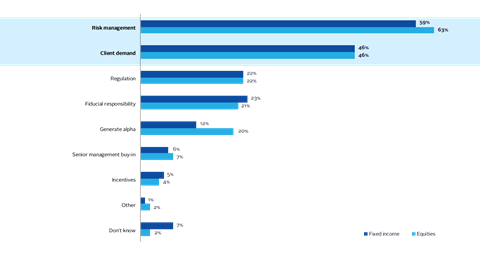By Justin Sloggett (@JustinSloggett), Head of ESG Investment Research, the PRI, and Matt Orsagh (@MattOrsagh), Director of Capital Markets Policy, CFA Institute.
The content in this blog is based on a CFA-PRI survey of 1,100 financial professionals (mainly CFA members) from around the world, as well as workshops in 17 markets, as part of a best practice report. For more information, see Guidance and case studies for ESG integration: Equities and fixed income.
Fixed income practitioners lag their equity counterparts when it comes to integrating ESG data into their investment analysis (see Table 1), reflecting a fading misconception that ESG integration and fixed income are incompatible.

It is fair to say that equities had a head-start on this front, given that the first application of responsible investment practices were to fundamental equity strategies. ESG integration in equities started gaining momentum at the start of the 21st century, and while ESG integration in fixed income is still in its relative infancy, it is expanding rapidly.
…while ESG integration in fixed income is still in its relative infancy, it is expanding rapidly.
Although fixed income portfolio managers and credit analysts have traditionally appeared somewhat nonchalant regarding ESG, that is not to say that it has escaped all radars. Indeed, some practitioners have been integrating ESG factors for quite some time – though few firms have been doing so on an ongoing, firm-wide basis.
Challenges to fixed income
One reason for the slow uptake of ESG integration in the fixed income space is the lower levels of active ownership in this asset class, while such a strategy has been a powerful driver of ESG integration in the equity world.
Unable to vote, bondholders find it harder to engage effectively due to limited access to management (for example, they don’t have a formal communication process such as an annual general meeting). However, as noted by participants from our CFA-PRI workshop series, it’s not that practitioners can’t engage with companies if they are a bondholder; bondholders can and do have access to, and regularly meet with, management.
Even so, the absence of voting rights has created a perception that it is difficult to integrate ESG factors into credit analysis, with Dutch workshop participants agreeing that widespread knowledge of how to integrate ESG into bonds is lacking. Echoing this, “limited understanding of ESG issues/integration” was ranked as the top global barrier to ESG integration among fixed income practitioners (see Figure 1) in our survey on ESG integration.

Other challenges come down to the characteristics of fixed income markets, with some participants in France of the view that fixed income markets rarely price in ESG issues. One reason given for this was that those markets are relatively illiquid compared to equity markets, with bondholders therefore less likely to act on ESG issues and events. There is also a belief that traditional financial factors such as interest rates and inflation have an overriding influence on prices, resulting in ESG issues not getting the attention they merit.
Meanwhile, participants from several European markets see ESG issues as having a bigger impact on a share price than on a bond price due to seniority, except in the case of default. Because shares are more exposed to ESG risks than bonds, shareholders will lose their money before bondholders if a company goes bankrupt; thus, the impact of ESG data for fixed income practitioners is cushioned. However, there would be a large price impact on bonds in such a scenario.
Fixed income practitioners must also deal with the fact they are operating in a bigger, more complex market, with a wider variety of instruments, maturities and issuing entities.
ESG and fixed income are compatible
Despite these challenges, a point made repeatedly at several workshops was that fixed income practitioners tend to be long-term investors, particularly pension funds and insurance companies. Therefore, ESG factors – which are also long-term in nature – are hugely significant to them.
In fact, according to one practitioner in South Africa, ESG integration is more important in fixed income than equities.
In fact, according to one practitioner in South Africa, ESG integration is more important in fixed income than equities. Because the former market is less liquid than the latter, when a major ESG incident does occur, there will be a greater impact on price and the issuer could even default. Our survey findings show that practitioners in all corners of the world believe that ESG issues impact corporate bond and sovereign debt prices, and that this impact will be even more visible by 2022 (see Figures 2 and 3 respectively).


The misconceptions surrounding ESG integration in fixed income seem to have contributed to a knowledge gap among fixed income practitioners. Workshop participants agreed that training is crucial to encourage greater ESG integration, including regarding the pricing in of ESG factors (see a related blog here). Encouragingly, this is already happening in response to rising client demand for fixed income products that consider ESG factors.
Our survey showed that client demand is the second largest driver of ESG in fixed income (see Figure 4). Fixed income practitioners are primarily integrating ESG factors into their credit analysis, and advanced practitioners are pricing in ESG factors into their security valuations, spread analysis and duration analysis.

This blog is written by PRI staff members and guest contributors. Our goal is to contribute to the broader debate around topical issues and to help showcase some of our research and other work that we undertake in support of our signatories.
Please note that although you can expect to find some posts here that broadly accord with the PRI’s official views, the blog authors write in their individual capacity and there is no “house view”. Nor do the views and opinions expressed on this blog constitute financial or other professional advice.
If you have any questions, please contact us at [email protected].








